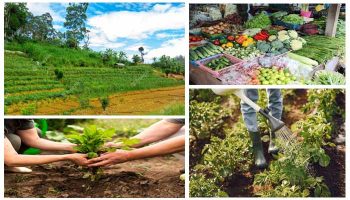

By Sujeewa Fernando Assistant Director ( Environment Pollution Control & Chemical Management ) Ministry of Environment
With the increase of world population, use of chemical fertilizers and pesticides has become popular to get high yields from a limited land area in a short period of time. This has led to environmental degradation over time and has caused adverse health impacts in humans. Therefore the time has come to reverse these impacts by promoting healthy soils, which leads to healthy crops and healthy people. According to World Food and Agricultural Organization, Organic agriculture is practiced in 187 countries, and 72.3 million hectares and managed by at least 3.1 million farmers
Benefits of organic farming;
1. Reduction of chemicals in soils: Use of organic fertilizers and pesticides lead to enrichment of soil micro- organisms. According to Dr. Elaine Ingham, just one teaspoon of compost-rich organic soil may host as many as 600 million to 1 billion helpful bacteria from 15,000 species. On contrary one teaspoon of soil treated with chemicals may carry as few as 100 helpful bacteria, which are needed for healthy growth of plants.

2. Combatting Erosion: Chemical pesticides kill cover crops which pave the path to soil erosion, degrading the soil, while organic farming supports soil formation and conditioning, waste recycling, nutrient recycling, carbon sequestration, and soil stabilization.

3. Enrich Bio-diversity: Chemicals kill many insects like bees and butterflies, which are very useful in pollination, in increasing the yield of the crops. Organic fertilizers promote bio diversity, which helps to maintain the equilibrium in ecosystems, reducing pest attacks and diseases in crops.

4, Prevents Algal Blooming: when chemical fertilizers are added to farmlands, they get washed off in to nearby water bodies, causing increase in algae growth, which leads to algal blooming. Once the algae die due to over crowding, certain types of algae release, algal toxins. These toxins can be neurotoxins or hepatotoxins whereas organic fertilizers do not release high concentrations of nutrients, to the surrounding environment.

5. Conservation of Water Resources: Organic farming will prevent leaching of chemicals in to ground,water polluting it. When farmlands are fed with chemical fertilizers, water bodies close to these farmlands, develop dead zones( without oxygen) due to excessive amounts of chemicals entering the water bodies. This affects aquatic fauna & flora. High concentrations of nitrates (from chemical fertilizers) in water causes blue baby syndrome (methemoglobinemia) tumours and gastro-intestinal cancers when consumed by human beings. Methemoglobinemia was observed in Nawakkaduwa in Mannar in the past. Heavy metals in pesticides too can cause cancer. Many chemical pesticides, mainly herbicides act as “Endocrine Disruptors” causing damage to the endocrine system/hormones in humans and animals .

The mulch used for crops under organic farming, will preserve moisture content in the soil, which is beneficial for the environment and crop production. Crops grown under organic farming, survive impacts of climate change like droughts better than farms under chemical farming.

Supports in preventing Climate Change: Organic farming helps in carbon sequestration, Research findings of Rodale Institute Farming Systems says that if only 10,000 medium sized farms in the U.S. are converted to organic production, they would store so much carbon in the soil ( carbon sequestration) that it would be equivalent to taking 1,174,400 cars off the road, or reducing car miles driven by 14.62 billion miles. Nitrous oxide emissions from fertilizers too contribute to climate change.
7. Enhances soil fertility: Chemical Fertilizers consists mainly of Nitrogen, Phosphorus and Potassium ( NPK)along with very few other micro nutrients. Essential micro nutrients that are needed for plant growth are boron (B), zinc (Zn), manganese (Mn), iron (Fe), copper (Cu), molybdenum (Mo), chlorine (Cl)]Fe, Zn. The organic fertilizers consist of these nutrients, as plant material and animal manure are used in producing it. Consequently the food crops absorb these. When the crops are fed by chemical fertilizers, those crops do not contain the required nutrition level, as it does not contain essential micro nutrients.
“Colombo Declaration on Sustainable Nitrogen Management” was signed on 24th October , 2019 spearheaded by Sri Lanka to minimize air, water and soil pollution due to nitrogen. It is targeted to halve Nitrogen waste by 2030.
Preparation of organic fertilizer: The following are the main steps in preparation of Organic Fertilizer;
1.A suitable site should be selected, then it should be cleared, leveled and draining facilities should be ensured to prevent accumulation of water. The site should not be closer to a drinking water well. Heap, Cage or Pit method of composting could be practiced in preparing organic fertilizer.
Follow the steps given below in producing organic fertilizer.
* Lay the green leaves as the first layer on the selected land.
*Lay the second layer on top of it which could be manure ( cow dung, poultry waste)
*Add micro organisms( which could be purchased) to layers of raw material to accelerate the process
*Stack several layers on top of the other, where each layer can be of 30cm in height. The width of the heap should be 90cm or 3 feet for easy management.
*Each layer should be sprayed with water considering the moisture content.
*Once all the layers are stacked, it should be covered with a black polyethene.
*After 3-4 weeks the 1st turning should be done. Then the heap should be covered again.
* After 7-8 weeks the second turning should be done, then it should be covered again.
*The 3rd turning should be done after 11.-12 weeks.
* Water should be added to the heap from time to time considering the moister level
*After 03 months the compost or the organic fertilizer can be used in your crop production..
The raw materials that could be used are, Green leaves, Gliricidia, Eppawala Rock phosphate, sow dusts, vegetable peelings, animal manure( Cow dung, poultry waste), banana leaves and trunk, weeds etc.
This organic fertilizer improves the soil fertility and retain the moisture in soil.
Methods of composting

Producing Organic Fertilizer
1.Stacking of layers with different types of raw materials.
2. Stacks covered with black polythene,

Turning of of the stack after 3-4 weeks,
7-8 weeks and 11-12 weeks 4. Final Product

“Lets save the environment by promoting healthy soils, by converting to organic farming”.
References:
https://www.thebalancesmb.com/environmental-benefits-of-organic-farming-2538317
http://www.fao.org/family-farming/detail/en/c/1378841/
http://www.agrimin.gov.lk/web/index.php/en/12-project/26-promotion-of-production?showall=&start=3
http://archives.dailynews.lk/2010/11/13/bus35.asp






